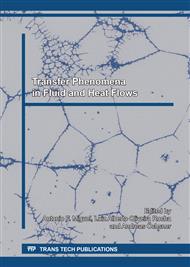[1]
STEVULOVA, N., JUNAK, J. Alkali-activated Binder Based on Coal Fly Ash. Chemické listy, 2014, 108(6), 620-623.
Google Scholar
[2]
ONDOVA, M., STEVULOVA, N. Benefits of fly ash utilization in concrete road cover. Theoretical foundations of chemical engineering, 2012, 46(6), 713-718.
DOI: 10.1134/s0040579512060176
Google Scholar
[3]
BOHÁČOVÁ, J., STANĚK, S., MEC, P. Preparation and properties of pressed metakaolin and fly ash based alkali-activated binders. Advanced Materials Research, 2014, 897, 65-68.
DOI: 10.4028/www.scientific.net/amr.897.65
Google Scholar
[4]
BŘENEK, A., VÁCLAVÍK, V., DVORSKÝ, T., DAXNER, J., DIRNER, V., BENDOVÁ, M., HARNIČÁROVÁ, M., VALÍČEK, J. Capillary active insulations based on waste calcium silicates. Advanced Structured Materials, 2015, 70, 177-188. DOI: 10. 1007/978-3-319-19443-1_14.
DOI: 10.1007/978-3-319-19443-1_14
Google Scholar
[5]
BŘENEK, A., VÁCALVÍK, V., DVORSKÝ, T., ŠIMÍČEK, V., VALÍČEK, J., KUŠNEROVÁ, M., HARNIČÁRÁROVÁ, M. Numerical moisture simulation of redeveloped structures using active materials based on cement composite. Materialwissenschaft und Werkstofftechnik, 2016, 47(5-6), 495-502. DOI: 10. 1002/mawe. 201600525.
DOI: 10.1002/mawe.201600525
Google Scholar
[6]
JURSOVÁ, S. Metallurgical Waste and Possibilities of Its Processing. In 19th International Conference on Metallurgy and Materials: Metal 2010, Rožnov pod Radhoštěm, 18. -20. 5. 2010, Tanger, spol. s r. o., Ostrava, 115-120. ISBN 978-80-87294-17-8.
Google Scholar
[7]
JURSOVÁ, S., WITKOWSKI, K., INGALDI, M. Logistics Flows of Metallurgical Aggregate Production. In Carpathian Logistic Congress, Cracow, Poland, 9. -11. 12. 2013, 458-462. ISBN: 978-80-87294-50-5.
Google Scholar
[8]
YU, X., TAO, Z., SONG, T.Y., PAN, Z. Performance of concrete made with steel slag and waste glass. Construction and Building Materials, 2016, 114, 737-746. DOI: 10. 1016/j. conbuildmat. 2016. 03. 217.
DOI: 10.1016/j.conbuildmat.2016.03.217
Google Scholar
[9]
PANG, B., ZHOU, Z., XU, H. Utilization of carbonated and granulated steel slag aggregate in concrete. Construction and Building Materials, 2015, 84, 454-467. DOI: 10. 1016/j. conbuildmat. 2015. 03. 008.
DOI: 10.1016/j.conbuildmat.2015.03.008
Google Scholar
[10]
QASRAWI, H. The use of steel slag aggregates to enhance the mechanical properties of recycled aggregate concrete and retain the environment. Construction and Building Materials, 2014, 54, 298-304. DOI: 10. 1016/j. conbuildmat. 2013. 12. 063.
DOI: 10.1016/j.conbuildmat.2013.12.063
Google Scholar
[11]
ANASTASIOU, E., K., GEORGIADIS FILIKAS a M. STEFANIDOU. Utilization of fine recycled aggregates in concrete with fly ash and steel slag. Construction and Building Materials. 2014, 50, 154-161. DOI: 10. 1016/j. conbuildmat. 2013. 09. 037.
DOI: 10.1016/j.conbuildmat.2013.09.037
Google Scholar
[12]
PALANKAR, N., RAVI SHANKAR, A.U., MITHUN, B.M. Durability studies on eco-friendly concrete mixes incorporating steel slag as coarse aggregates. Journal of Cleaner Production, 2016, 129, 437-448. DOI: 10. 1016/j. jclepro. 2016. 04. 033.
DOI: 10.1016/j.jclepro.2016.04.033
Google Scholar
[13]
KRAYUSHKINAA, K., PRENTKOVSKIS, O., BIELIATYNSKYIA, A., JUNEVIČIUS, R. Use of steel slags in automobile road construction. Transport, 2012, 27(2), 129-137.
DOI: 10.3846/16484142.2012.690093
Google Scholar
[14]
ASI, I.M., QASRAWI, H.Y., HALABI, F.I. Use of steel slag aggregate in asphalt concrete mixes. Canadian Journal of Civil Engineering, 2007, 34(8), 902-911.
DOI: 10.1139/l07-025
Google Scholar
[15]
WU, S., XUE, Y., YE, Q., CHEN, Y. Utilization of steel slag as aggregates for stone mastic asphalt (SMA) mixtures. Building and Environment, 2007, 42(7), 2580-2585.
DOI: 10.1016/j.buildenv.2006.06.008
Google Scholar
[16]
REAL, S., GOMES, M.G., MORET, R.A., BOGAS, J.A. Contribution of structural lightweight aggregate concrete to the reduction of thermal bridging effect in buildings. Construction and Building Materials, 2016, 121, 460-470. DOI: 10. 1016/j. conbuildmat. 2016. 06. 018.
DOI: 10.1016/j.conbuildmat.2016.06.018
Google Scholar
[17]
JAYALATH, A., SAN NICOLAS, R., SOFI, M., SHANKS, R., NGO, T., AYE, L., MENDIS, P. Properties of cementitious mortar and concrete containing micro-encapsulated phase change materials. Construction and Building Materials, 2016, 120, 408-417. DOI: 10. 1016/j. conbuildmat. 2016. 05. 116.
DOI: 10.1016/j.conbuildmat.2016.05.116
Google Scholar
[18]
KULOVANA, T., VEJMELKOVA, E., POKORNY, J., SIDDIQUE, J.A., KEPPERT, M., ROVNANIKOVA, P., ONDRACEK, M., KERSNER, Z., CERNY, R. Engineering properties of composite materials containing waste ceramic dust from advanced hollow brick production as a partial replacement of Portland cement. Journal of Building Physics, 2016, 40(1), 17-34. DOI: 10. 1177/1744259115597228.
DOI: 10.1177/1744259115597228
Google Scholar
[19]
EN 12390-3 Testing hardened concrete - Part 3: Compressive strength of test specimens.
Google Scholar
[20]
EN 12390-3 Testing hardened concrete - Part 7: Density of hardened concrete.
Google Scholar
[21]
EN 12390-8 Testing hardened concrete - Part 8: Depth of penetration of water under pressure.
Google Scholar
[22]
Directive of the European Parliament and Council Directive 2010/31/EU on the energy performance of buildings.
Google Scholar
[23]
KUSNEROVA, M., VALICEK, J., HARNICAROVA, M. Measurement of physical properties of polyurethane plaster. Gradevinar, 2014, 66(10), 899-907.
Google Scholar


